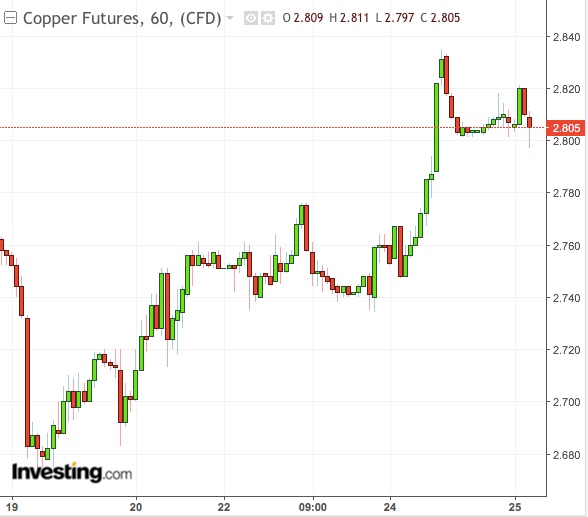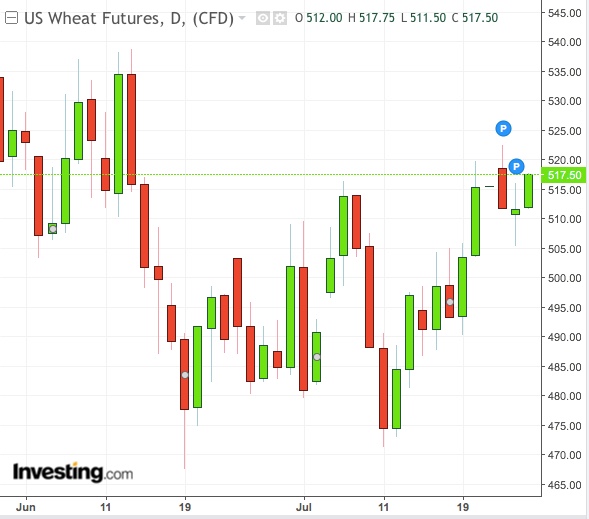Supply and demand issues are back to determining the direction of commodity markets, with geopolitics playing an additional vital role in oil, after Donald Trump’s clash with the Fed over rate hikes put greater emphasis on non-currency fundamentals.
Few US Presidents have tried to tell the Federal Reserve what to do with monetary policy and it remains to be seen whether Trump will triumph.
The dismay he’s expressed over the central bank’s preference for a strong dollar, however, has spawned enough consternation in forex circles to leave the USD quite directionless since Friday’s sharpest one-day fall in three weeks. This is despite the manufacturing PMIs for both the US and Europe trouncing expectations on Tuesday, and the US-China trade row continuing without letup. Deutsche Bank captured the mood succinctly in its Tuesday note, saying: “After all the excitement following the various headlines at the back end of last week, the last 24 hours has proven to be fairly tame by comparison.”
With the lackluster dollar barely impacting commodities this week—compared to a week ago when the USD’s rally made owning anything from energy to metals and agriculture costlier, the focus is back to raw material inventories.
US Oil Data, Iran Squabble On Radar
In oil, all eyes will be on the US crude stockpiles data for the week to July 20, due at 10:30 AM ET (14:30 GMT) from the Energy Information Administration (EIA). The bet is for a decline of more than 2.3 million barrels – compared to the previous week, when there was a buildup of nearly 5.9 million.
Trade group American Petroleum Institute (API) bolstered oil bulls’ expectations on Tuesday by citing a drawdown of 3.16 million barrels for last week. API’s inventory sampling is way smaller than the EIA’s, and contributed voluntarily by industry members, unlike the mandatory reporting required by the government agency. While their numbers typically diverge, there have been occasions when the API has presciently called the EIA’s crude stockpile reading.
Tight oil inventories in the US and abroad have stoked investor expectations for a global supply shortage, with some market participants cautioning that even a small disruption in output could result in "dangerous" price volatility. With US crude inventories already near 3-year lows, the significance of the API being right again with its larger-than-estimated drawdown cannot be understated. Beyond sheer inventory loss, there are clear and present signs of supply disruptions from various geopolitical factors involving Iran, Libya and Venezuela. Chief among them is the US-Iran squabble.
On the demand side, China's State Council has announced increased spending, tax breaks and special bonds for infrastructure spending, again seen as positive for oil.
“With global spare oil production capacity at less than 2% of demand and the prospect for increasing demand out of China, we see the risks weighted to the upside longer term,” said Phil Flynn, energy analyst the Chicago-based Price Futures Group.
In the nearer-term, charts show US West Texas Intermediate (WTI) crude would be looking to return to the $70 per barrel level it fell under last week. Investing.com’s Fibonacci readings on a daily basis for WTI put first resistance at $68.99, second at $69.34 and third at $69.89. The pivot was at $68.44.

UK Brent, the global oil benchmark, will, meanwhile, seek to make a run for $75 per barrel, charts indicate. Fibonacci patterns on a daily basis put first resistance for Brent at $73.98, second at $74.28 and third $74.44. The pivot was at $73.49.
Metals Look Toward China Stimulus; Copper On Rebound
China’s move toward economic stimulus was also welcome news in the base metals markets, with the world's No. 2 economy already consuming more than half of global copper, nickel and steel.
US copper soared 2.5% on Tuesday for its largest one-day gain in more than three months. Just a week ago, the top industrial metal was languishing at one-year lows, with some analysts predicting it will get worse before it gets better.
Copper futures on the COMEX division of the New York Mercantile Exchange settled on Tuesday at $2.806 a lb, its highest in two weeks. Investing.com’s daily technicals suggest a “Buy”, with Fibonacci readings quite a way off before encountering first resistance at $2.831, second at $2.854 and third $2.893. The pivot was at $2.792.

Copper prices also rebounded this week on fears of work disruption at Chile’s Escondida copper mine, underscoring the return of supply-demand fundamentals across commodities as the dollar’s influence waned. The management at Escondida, controlled by BHP Billiton (LON:BLT), said it was due to deliver its final offer to the mine’s labour union on Tuesday to fend off a possible strike.
TD Securities said it was among those that joined Tuesday’s rally in copper.
“China stands ready to stimulate its economy, while we think the dollar's best days are behind us—these key factors could serve to support base metals in the coming months,” it said in a note.
“As signs emerged that the bottom is in sight for base metals, we opted towards buying copper ahead of possible souring negotiations at the world's largest mine,” it said, referring to Escondida.
Wheat Could Be Winner In Agriculture
On the agricultural side, wheat has come into focus for a potential run up from recent levels, ADM Investor Services said in a note.

“The cross over and close above the 40-day moving average is an indication the longer-term trend has turned positive,” it said.
